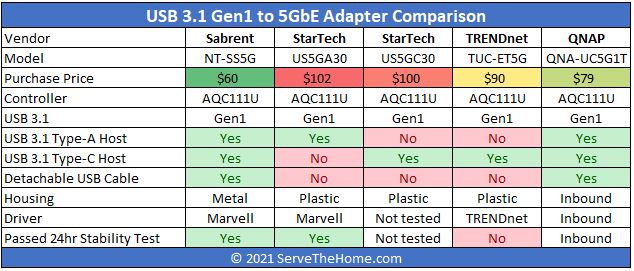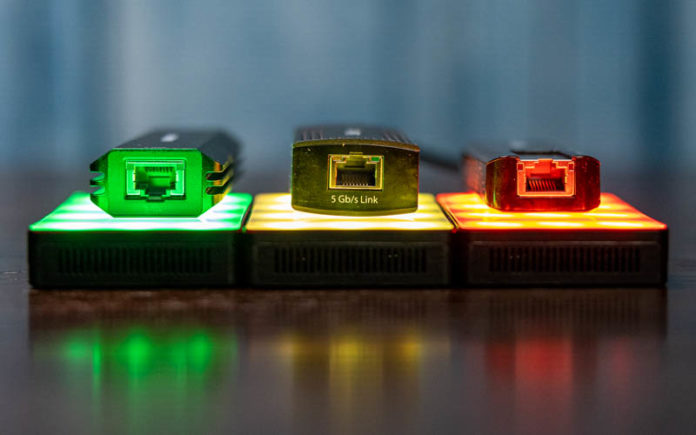Recently, we published a series on various USB 3.1 Gen1 to 5GbE network adapters. We decided to put together a summary of what we observed to make it easy for our readers to see the differences. We are pushing “faster than 1GbE” speeds in 2021, so this is part of our push to move the industry forward.
USB 3.1 Gen1 to 5GbE Network Adapter Guide
Here is a quick summary table of the units we have tested, are told are virtually identical to the units we reviewed (e.g. the StarTech US5GC30) or have inbound for testing.

We will update this chart in the future as we get more units tested. An example is that we received feedback on our recent review series that readers wanted to see the QNAP QNA-UC5G1T reviewed so we have those units inbound so we can test them on the same systems. We are also using Amazon pricing for each unit as our Purchase Price. There may be discounts that we did not receive or higher prices elsewhere.
Here is a quick video discussing the Sabrent, StarTech, and TRENDnet adapter versions:
That video discusses some of the key findings we had when reviewing the first three units. We expect subsequent units we test to generally follow the guidelines here.
USB 3.1 Gen1 to 5GbE Network Adapter Reviews
Here is a quick list of the units we have reviewed to date. We will keep this updated:
- Sabrent NT-SS5G Review USB to 5GbE NIC
- StarTech USB to 5GbE Adapter Review (US5GA30)
- TRENDnet TUC-ET5G USB Type-C to 5GbE NIC Review
A quick note here. We have the StarTech US5GC30 in the table above. We were alerted that this is the same unit except with a Type-C instead of a Type-A connector on the USB side. We also have the QNAP QNA-UC5G1T units inbound based on the feedback we received with the initial set of results. Many have said this unit is similar to the Sabrent unit, but we will verify this as we get further into the review process.
Final Words
We know many of our readers want summarized information. At first, this was a series that was supposed to run bi-weekly on STH and without a video. That turned out to not be how they actually were published due to what we saw with the units and our desire to test on a number of systems.





I don’t understand why these brands are shooting themselves in the foot.
They use the expression “5 GbE” knowing perfectly that each of these product DO NOT deliver 5 GbE networking.
Even the Marvell “marvell-ethernet-controllers-aqtion-aqc111u-112u-product-brief.pdf” brochure plays with the words: “…Integrated USB v3.1 Gen1 PHY…Supports line rates of up to 5 Gbps…”.
Yes you get 5 Gbps supported by the USB v3.1 Gen1 PHY BUT you are not buying a USB device, you are buying a NETWORK device and this device qualified as 5 GbE is not in any shape of form supporting 5 GbE.
It is not even supporting close to 4 Gbits/sec. The usually practical max throughput for a 2.5 GbE adapter is 2.35 Gbits/sec so you would expect about 4.70 Gbits/sec practical max throughput for a 5 GbE adapter. All these products are stuck at 3.5-3.7 Gbits/sec. In other words, 1 Gbits/sec is Missing In Action.
This is the same level of deceptiveness as WD which was selling SMR drives without telling people. They are playing “Catch Me if You Can” just for the love of $$$.
No thanks.
Overall I am so thankful that Sth did this amazing review, comperation great work. Please please do 10gbe cards, thunderbolt reviews.
ps would a vendor in theory use an existing 10gbe chip and scale it to run at 5gbe?
The overheads causing lack of efficiency is a bummer, but hey it’s better than using >3x 1g adaptors.
My understanding is that USB 3.1 gen1 is 5gbps *bidirectional*. Given this, did you happen to do any bidirectional throughput tests? If so, what was the total bandwidth?
And as a stickler for details… Did you do any packets per second tests? If so, can you provide the results?
I’m not lame enough to ask you to go and test the things I’ve asked about if you didn’t test them the first time – it’s not that important to me.
Oh, ok. Just did some more reading.
For USB 3.1 gen1 the *line* rate is 5gbps, this is pre the line encoding which happens to be 8b/10b.
Alas the maximum throughput available to the USB device is actually 4gbps each way.
So the measured 3.45gbps in one direction is not ridiculously ridiculous.
Would it also be possible to get the Delock USB 3.1 Gen1 to 5GbE Network Adapter (P/N: 66088) for a review?
Patrick, I really enjoyed your video review here.
I’m maintaining a small SOHO LAN with a mixture of PCIe 1.0 and PCIe 2.0 motherboards.
A few have integrated USB 3.0 ports on the rear panel, and
a few have add-in cards with USB 3.0 ports installed in expansion slots.
I don’t mind spending a little extra money to do some experimentation.
My question concerns the SWITCH you would recommend.
My thinking is that a SWITCH that auto-detects 2.5GbE and 5.0GbE
would give us more flexibility with this diversity of old hardware.
Our old hardware is really only doing storage backups,
so the data rate is an important issue, even for that old hardware.
Can you recommend a 5.0/2.5 GbE switch that will allow us to begin
testing with from 2 to 5 workstations?
I’m pretty sure I can figure out the best wiring topology.
Many thanks for a very clear and informative video.
FYI: here’s a comment I let at the lon.tv YouTube channel:
Lon does super clear tech reviews (highly recommended):
Sabrent 2.5 and 5 gig USB Ethernet Adapters Review
Nice clear summary, Lon. THANKS! I came across this video because I’ve just starting shopping and comparing similar devices. Suggestion: if/when you are ever speaking with a manufacturer’s engineers, please remember to make them aware of the difference in “frame” layout between 8b/10b “legacy frame” and 128b/130b “jumbo frame”. In addition to the obvious differences in transmission speeds, the 8b/10b legacy frame necessarily adds 20% overhead all the time (because of the extra start bit and extra stop bit added to every byte transmitted). The jumbo frame adds one start bit and one stop bit to a frame of 16 bytes @ 8 bits per byte: 16 x 8 = 128 + 1 start bit + 1 stop bit = 130 bits per 16 bytes. Lastly, one future goal for these devices is to implement AUTO DETECTION across the board e.g. automatic detection of speeds, frame sizes and any other parameters that should be decided by device negotiation with the host at plug-in time. For an obvious example, modern SATA-III (6G) SSDs are backwards compatible with SATA-II (3G) and SATA-I (1.5G) ports, no other user involvement is required. Unfortunately, SATA has remains STUCK with the 8b/10b “legacy frame”: 6G / 10 = 600 MB/s MAX HEADROOM. Thanks again and KEEP UP THE GOOD WORK!
Please correct me if any of the following is not correct:
SATA-III and USB 3.0 both use the 8b/10b “legacy frame”:
1 start bit + 8 data bits + 1 stop = 10 bits per byte
SATA-III 6G / 10 = 600MB/second (MAX HEADROOM)
USB 3.0 5G / 10 = 500MB/second (MAX HEADROOM)
The latter are both theoretical maxima,
which do NOT reflect any controller overhead.
Now, factor in the jumbo frame effects:
PCIe Gen3 jumbo frame = 128b/130b = 130 bits / 16 bytes = 8.125 bits per byte
USB 3.1 jumbo frame = 128b/132b = 132 bits / 16 bytes = 8.250 bits per byte
USB 3.1 10G / 10.0 = 1,000MB/second
USB 3.1 10G / 8.25 = 1,212MB/second
Again, the latter are both theoretical maxima,
which do NOT reflect any controller overheads.
Thus, the bottleneck is clearly the USB 3.0 “5G” connector + legacy frame
at the host end.
As I wrote to Lon (see copy of my comment above),
the industry should embrace an industry-wide
standard that adopts AUTO-DETECTION at plug-in time:
all such factors affecting performance so directly
should be automatically negotiated between each
future USB device and the host, at the moment the
USB connector is plugged in.
And, to repeat the wisdom of modern 6G SSDs,
implement thorough backwards compatibility
to host USB ports running at slower speeds
and host USB ports that still utilize the
8b/10b legacy frame.
Hope this helps. Again, please correct any
errors I may have made above.
p.s. I was half-way thru this draft,
when this Comment Forum completely erased
my first draft. DID I DO SOMETHING WRONG?
TYPO POLICE:
comment I let at the lon.tv
should have been
comment I left at the lon.tv
30 lashes with a wet noodle 🙂
Re: QNAP model QNA-UC5G1T (mentioned above)
Wow. This is really confusing.
At their web page for this QNAP device,
see the following:
Cable CAB-U310G10MCC
USB 3.1 Gen2 10G 1.0m Type-C to Type-C cable
Cable CAB-U35G02MAC
USB 3.2 Gen1 5G 0.2m Type-A to Type-C cable
But, above those cable specs, find this:
I/O: 1 x USB 3.2 Gen 1 Type-C; 1 x 5GbE/NBASE-T port
Note where the latter says “USB 3.2 Gen 1”.
Am I correct to infer from those cable specs that
the USB interface (controller) only runs at 5G,
as Patrick Kennedy has already explained?
Forgive me for my confusion: I must confess that
I am still somewhat bewildered by all these different
USB specs: USB 3.0, 3.1, 3.2, Gen1 and Gen2.
Making matters MUCH WORSE, their video
at the QNAP website says:
Host “USB 3.1 Gen 1 PHY”
Greetings again, Patrick:
Can you tell us when you might be reviewing the QNAP dongle?
KEEP UP THE GOOD WORK!
/s/ Paul
VLAN does not work with the Sabrent adapter and the current Windows 10 driver.
I left a post with more details in the forum:
Forum > STH – Resources > STH Main Site Posts > Sabrent NT-SS5G Review USB to 5GbE NIC
I have TVS-672XT NAS, QNAP SW-308-1C switch with Wiitek SFP-10G-T adaptors in the SFP ports and QNA-UC5G1T USB adaptor for the PC. I’m using factory made Cat8 patch cables. I experience the following issues:
– cable length – SFP connects to NAS at 10Gbps with 10m cable, but only at 5Gbps with 20m cable
– SFP to USB adaptor – file copy speed too low. QSW-308-1C with Wiitek SFP-10G-T adaptors in the SFP ports. QNA-UC5G1T status in Windows is always 5Gbps. When connected to the SFP (via Wiitek SFP-10G-T) speed is 140MB/s. When connected to the Combo port speed is 324MB/s. File source is TVS-672XT connected to SFP (via Wiitek SFP-10G-T) or Combo port. When using two clients simultaneously (QNA-UC5G1T at Combo port + regular 1Gbps PC at one of the 1Gbps ports) combined speed of the two PCs is 444MB/s (324MB/s + 120MB/s). Why are the SFP ports (or SFP adaptors) lowering the speed so much when used with QNA-UC5G1T?
So, when doing the QNA-UC5G1T review, please check compatibility with Wiitek SFP-10G-T/SW-308-1C and for Wiitek SFP-10G-T/SFP adaptors in general – please do tests with different cable lengths.
Are we still going to see a review of the QNAP adapter here ?
By now these should all have been USB 3.2 Gen 2 at least. It is so disappointing that we are still stuck with Gen 1. Because of the USB bottleneck, they are really 2.5 Gbps adapters.
And if you just want to connect 2 machines and both have Thunderbolt 3/4 ports, you can skip the adapters and directly connect a TB to TB cable to network them.
Has anyone tried the QNA-UC5G1T in a USB 3.1 G1 Type-C port? On the QNAP website they are saying it’s a USB 3.2 device. Wanted to check if it works with the port on my HP Z2 Mini G3 workstation before shelling out the $$.